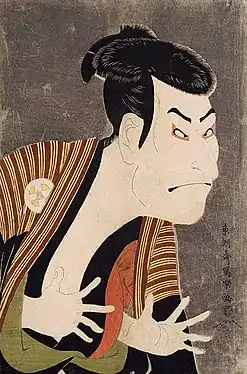One Hundred Aspects of the Moon
One Hundred Aspects of the Moon or Tsuki no Hyakushi (月百姿) in Japanese is a collection of 100 ōban size ukiyo-e woodblock prints by Japanese artist Tsukioka Yoshitoshi printed in batches, starting in 1885 until 1892.[1] It represents one of Yoshitoshi's later works. The woodblock prints feature various famous figures, both historical and literary characters, each in a moonlit scene as well as occasional references to poetry.
History
This series of 100 prints was published in 1885-92 by Akiyama Buemon. The subjects are drawn from various sources in Japanese and Chinese history and literature, Kabuki and Noh theatre, and even contemporary Tokyo, linked only by the presence of the moon in each print. The creation of mood according to the phase of the moon was exploited for its poetic and expressive possibilites. This was the most successful and still the most famous of Yoshitoshi’s print series. People would queue before dawn to buy each new design and still find the edition sold out.[2]
List of prints
| # | Image | Name | Description[3] |
|---|---|---|---|
| Index page |  |
||
| Title page |  |
||
| 1 |  |
The Courtesan Takao | Takao was a name used by eleven courtesans in the Yoshiwara district of Edo. Here is the 6th Takao, known for her literary talents and dressed by the fashion of the late 17th century. "The haiku in the cartouche describes her longing for her lover: 'By now you must be/ somewhere near Komagata/ A nightingale is singing.'"[4] |
| 2 | 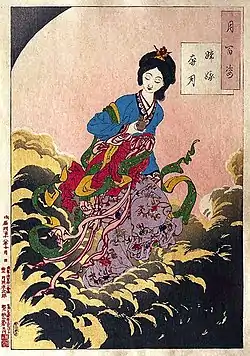 |
Chang'e flees to the moon
(Joga hongetsu tsuki) |
The goddess of the moon, Chang'e |
| 3 | 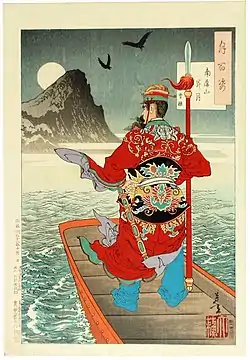 |
Rising moon over Mount Nanping (Nanpeizan shogetsu) | Cao Cao viewing the Red Cliffs |
| 4 | 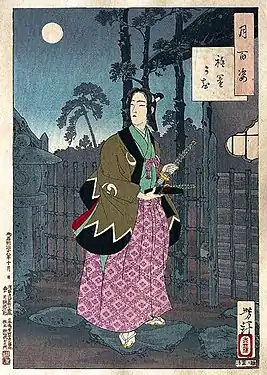 |
The Gion District (Gionmachi) | The district of Gion |
| 5 | 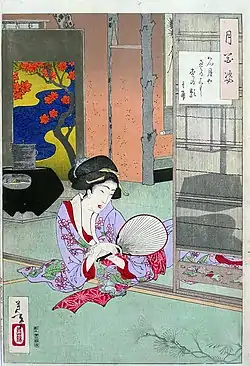 |
Woman watching the shadow of a pine branch cast by the moon | "Full Moon/ On the Tatami Mats/ Shadows of the Pine Branches", haiku poetic verse by Takarai Kikaku |
| 6 |  |
The village of the Shi clan on a moonlit night (Shikason tsukiyo) | The Village of the Shi Clan on a Moonlit Night - Nine-Dragon Tattoo from "The Water Margin", featuring Shi Jin |
| 7 | 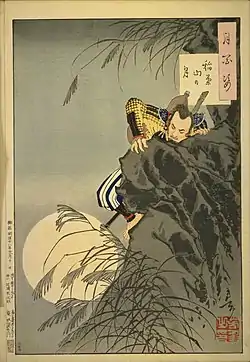 |
Inaba Mountain moon (Inabayama no tsuki) | The Siege of Inabayama Castle |
| 8 | 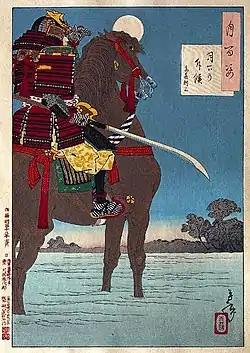 |
Moonlight Patrol (Gekka no sekko) | Saitō Toshimitsu at the Battle of Yamazaki |
| 9 | 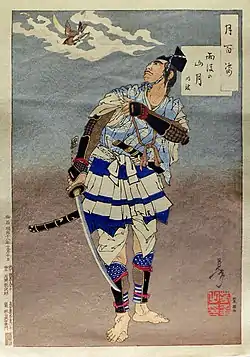 |
Mountain moon after rain (Ugo no sangetsu) | Soga Tokimune viewing a moonlit mountain after rainfall |
| 10 |  |
Moon of pure snow at Asano River (Asanogawa seisetsu no tsuki) | Moon of Pure Snow at Asano River - Chikako, the Filial Daughter. Chikako was the daughter of Zeniya Gohei who was wrongfully imprisoned. |
| 11 | 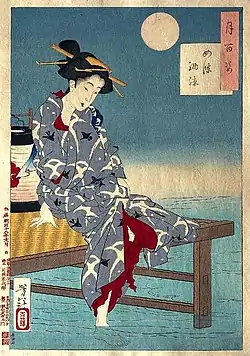 |
Cooling off at Shijo (Shijo noryo) | |
| 12 | _Tsuki_hyaku_shi_-_Daimotsu_kaij%C5%8D_no_tsuki-.jpg.webp) |
Moon above the Sea at Daimotsu Bay: Benkei (Daimotsu kaijô no tsuki - Benkei) |
"The story of the heroic deeds of Yoshitsune no Minamoto and his loyal servant, the warrior-priest Benkei, was told in the Heike Monogatari (Tale of the Heike) and the Gikeiki (Story of Yoshitsune), and retold many times in plays and prints. This legendary episode was the central subject of famous Noh and Kabuki plays, including the version of Fuwa Benkei (Benkei in the Boat) starring Danjûrô IX premiered in 11/1885. After Yoshitsune’s decisive win over the Taira clan at the battle of Dannoura in 1185, he was outlawed by his brother Yoritomo and forced to flee the capital with his followers. Setting sail, they were caught in an unusually violent storm and heard the spirit voices of the Taira warriors calling for revenge.
A host of dead warriors appeared above the waves and were only quelled when Benkei confronted them, with his rosary in hand, reciting prayers and spells. Kuniyoshi had depicted this episode in prints with the ghosts clearly visible; Yoshitoshi makes them less tangible, but evokes their presence in the shapes of the black clouds. In fine early impressions such as this example, mica scattered on the surface shines when the print is moved in the light, depicting the moonlight glittering on the dark waves." Block-cutter: Enkatsu (Noguchi Enkatsu). Publisher: Akiyama Buemon. First edition January 1886[5] |
| 13 | 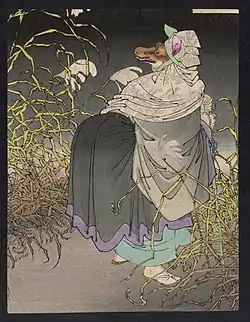 |
The cry of the fox (Konkai) | The Cry of the Fox, specifically a Kitsune |
| 14 | 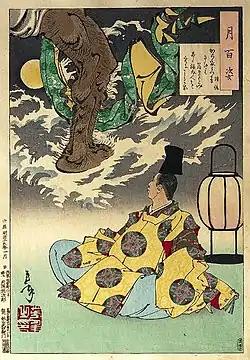 |
Tsunenobu and the demon | "I Listen to the Sound of the Cloth Being Pounded/ As the Moon Shines Serenely/ And Believe that There is Someone Else/ Who Has Not Yet Gone to Sleep", poetic verse by Minamoto no Tsunenobu |
| 15 | 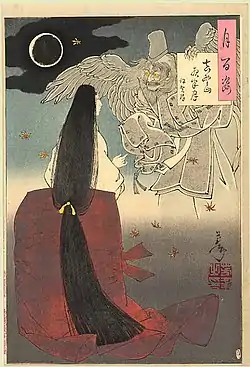 |
Mount Yoshino midnight-moon (Yoshinoyama yowa no tsuki) | "Against the advice of his general Masashige, Emperor Go-Daigo (1288-1339) was encouraged by courtier Sasaki Kiyotaka, for his own political gain, to fight the rebelling forces of Ahikaga Takauji at the battle of Minatogawa in 1336. As a result of losing the battle, Masashige committed suicide and the Emperor fled to Mount Yoshino, where Kiyotaka was also forced to commit suicide. Kiyotaka’s ghost haunted and harried the exiled courtiers, none of whom dared to face it. Finally it was confronted by Masashige’s daughter-in-law, the heroic Iga no Tsubone, who drove it away.
Like all the prints in this series, the white title cartouche is embossed with the pattern of a textile. The ghost has blue lips, a convention also used for corpses. Iga no Tsubone’s hair is remarkable both for its fine carving, and for the part it plays in one of Yoshitoshi’s boldest designs." Block-cutter: Enkatsu (Noguchi Enkatsu). Publisher: Akiyama Buemon. First edition January 1886[6] |
| 16 | 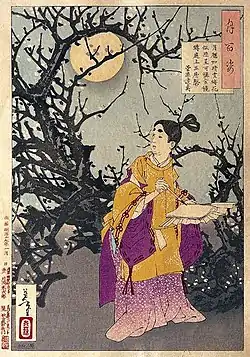 |
Michizane composes a poem by moonlight | "The Moon Glimmers like Bright Snow/ And Plum Blossoms Appear like Reflected Stars/ Ah! The Golden Mirror of the Moon Passes Overhead/ As Fragrance from the Jade Chamber Fills the Garden", poetic verse by Sugawara no Michizane |
| 17 | 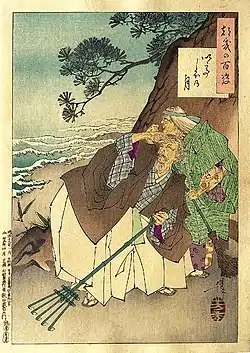 |
The moon at high tide (Ideshio no tsuki) | |
| 18 |  |
An iron cauldron in the moonlit night (Tsukiyo no kama) | An Iron Cauldron and the Moon at Night - Kobuna no Gengo and Shimaya Hanzō |
| 19 | 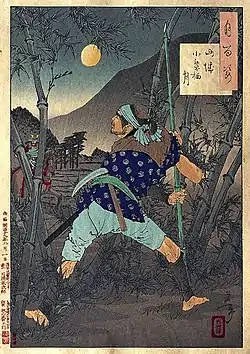 |
The moon of Ogurusu in Yamashiro (Yamashiro Ogurusu no tsuki) | The Moon at Ogurusu in Yamashiro, featuring Akechi Mitsuhide |
| 20 | 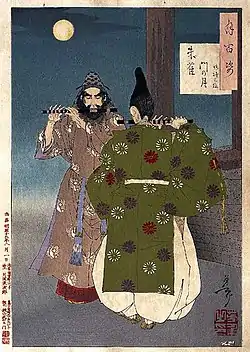 |
Suzaku Gate moon (Suzakumon no tsuki) | "Hakuga Sammi is the Chinese reading of the name and court rank of Minamoto no Hiromasa (918-80), grandson of Emperor Daigo. He was a famous musician, equally adept at playing a variety of wind and string instruments. We see him here from the rear, wearing the robes and lacquered hat of a Heian courtier, and playing the yokobue, a transverse flute. He is outside the Suzaku Gate of the Daidairi enclosure in Kyoto, which contained the imperial palace and government offices. The identity of his companion is uncertain, but judging from his hat and beard he is probably a foreigner.
Hiromasa’s skill on the flute was legendary and the beauty of his playing is recounted in numerous tales. One of them tells of him being robbed of all his possessions except a wooden flute (hichiriki). When he picked up the remaining flute and started to play, the sound carried through the streets to the ears of the robbers. They were so moved by its beauty that they repented their crime and returned Hiromasa’s possessions." Block-cutter: Yamamoto (Yamamoto Shinji). Publisher: Akiyama Buemon. First edition 02/1886[7] |
| 21 | 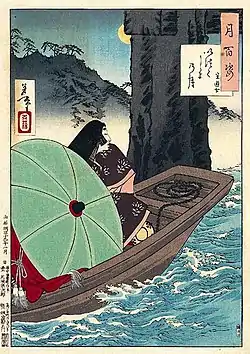 |
Itsukushima moon (Itsukushima no tsuki) | |
| 22 |  |
Moon and Smoke (Enchû no tsuki) |
"A contemporary scene showing an everyday hero in Tokyo, a tinder-box town built of wood and paper. Throughout his career, Yoshitoshi depicted firemen in his prints. Not only were they popular, daredevil figures with something of the heroic appeal of actors and wrestlers, but their distinctive costumes and geometric standards (matoi) made them very picturesque. Their quilted jackets were soaked with water to make them more resistant to fire, and they could be reversed when the fire was over to reveal a colourful lining. The character on the back of this jacket reads matoi, indicating that this is the standard bearer for the brigade fighting the fire in the foreground.
The character on the hat shows that he belongs to Number One Company. Standards were held aloft on roof tops so that each brigade could be identified and so that firemen could signal above the flames and noise. A distant fireman holds another standard on the roof opposite. There was great rivalry between the district brigades because the particular brigade that saved each property was rewarded. Spattered red lead that has blackened gives texture and atmosphere to the smoke and flames." Block-cutter: Yamamoto (Yamamoto Shinji). Publisher: Akiyama Buemon. First edition February 1886[8] |
| 23 | 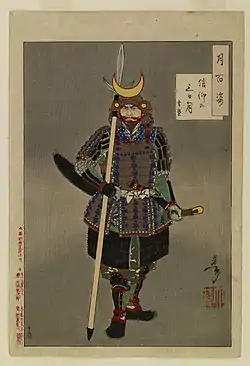 |
Faith in the third-day moon (Shinko no mikazuki) | |
| 24 |  |
Moon of the pleasure quarters (Kuruwa no tsuki) | |
| 25 | 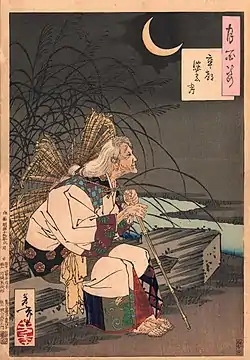 |
Gravemarker moon (Sotoba no tsuki) | |
| 26 | 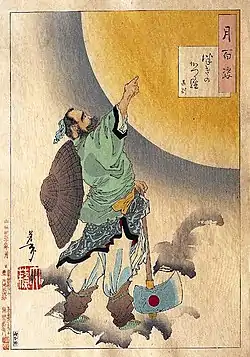 |
Cassia-tree moon (Tsuki no katsura) | |
| 27 | 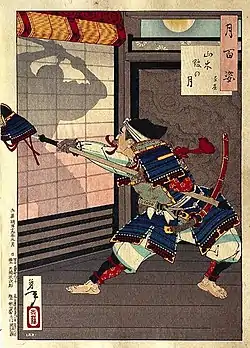 |
Moon at the Yamaki Mansion (Yamaki yakata no tsuki) | |
| 28 |  |
Chikubushima moon (Chikubushima no tsuki) | |
| 29 | 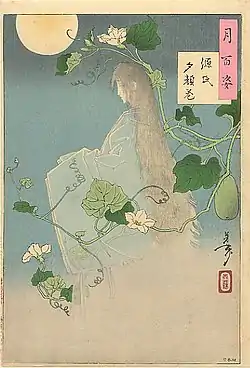 |
The Yugao chapter from The Tale of Genji (Genji yugao maki) | "This diaphonous figure is the ghost of the most mysterious of Prince Genji's lovers in The Tale of Genji, the 11th-century classic by Murasaki Shikibu, who was depicted in another print in this series. In Chapter 4 of the novel, Genji is on the way to visit his old nurse when he is attracted by the white flowers of a gourd overrunning the garden of a dilapidated house. He asks a servant to fetch a bloom and it is returned on a fan inscribed with a poem referring to his ‘evening face’, the literal meaning of yûgao, the name of the flower (Lagenaria siceraria). He courts the mysterious author of the poem, and takes her to a nearby villa, where she is visited in the middle of the night by the jealous spirit of one of Genji's lovers; she breaks into a fever and within hours she is dead. Genji is overcome with grief and years later still longed for a further glimpse of the woman who faded as quickly as the white flowers in her garden.
The print shows her ghost floating through her garden on the night of a full moon: yûgao was also known as ‘moonflower’, thus linking the subject to the theme of the series. Her lips are blue, a convention for the depiction of ghosts and corpses. Blind embossing is used to give form to the white petals of the flowers." Block-cutter: Yamamoto (Yamamoto Shinji). Publisher: Akiyama Buemon. First edition March 1886[9] |
| 30 | 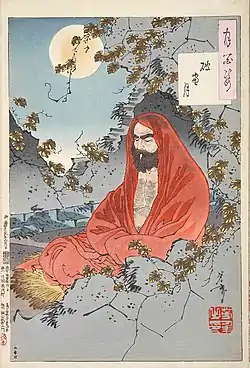 |
The moon through a crumbling window (Haso no tsuki) | The legendary Indian-Buddhist monk Bodhidharma was said to have journeyed to China to bring Zen teachings, and was reputed to have meditated in front of a wall for years until his arms and legs atrophied and fell off. |
| 31 | 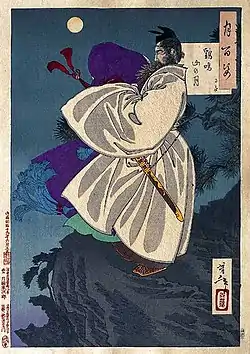 |
Mount Ji Ming moon (Keimeizan no tsuki) | |
| 32 | 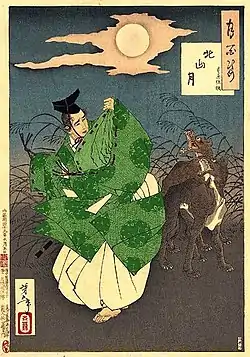 |
Kitayama moon (Kitayama no tsuki) | |
| 33 |  |
Dawn moon of the Shinto rites (Shinji no zangetsu) | |
| 34 | 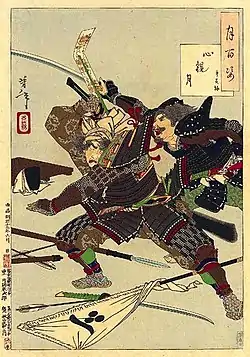 |
The moon's inner vision (Shinkan no tsuki) | |
| 35 | 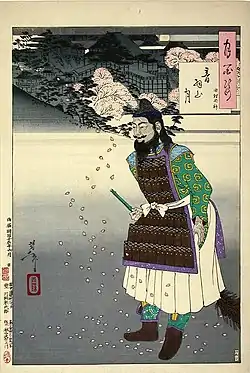 |
Mount Otowa moon (Otowayama no tsuki) | |
| 36 | 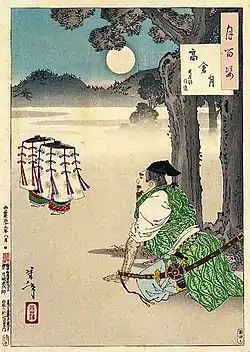 |
Takakura moon (Takakura no tsuki) | |
| 37 | 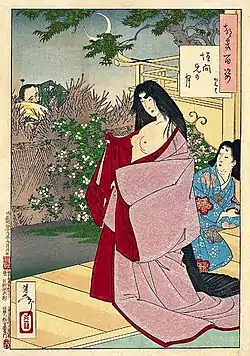 |
A glimpse of the moon (Kaimami no tsuki) | |
| 38 | 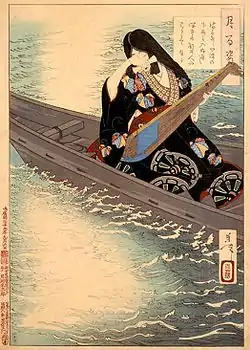 |
Ariko weeps as her boat drifts in the moonlight | |
| 39 |  |
Inamura Promontory moon at daybreak (Inamurgasaki no akebono no tsuki) | |
| 40 | 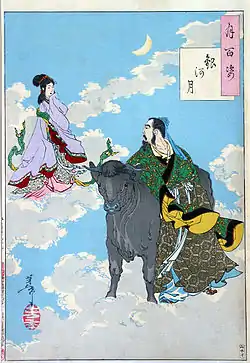 |
The Moon of the Milky Way (Ginga no tsuki) | |
| 41 | 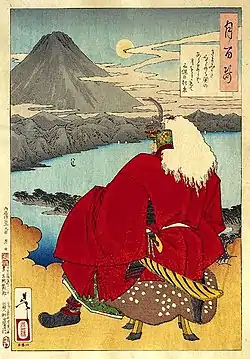 |
Moon over the pine forest of Mio | |
| 42 | 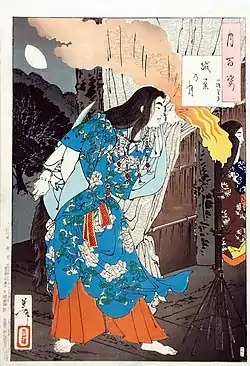 |
Moon of the enemy's lair (Zokuso no tsuki) | |
| 43 | 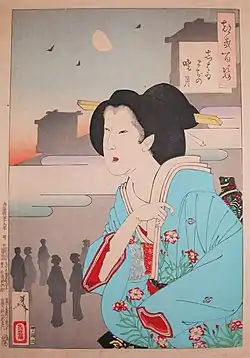 |
Theater-district dawn moon (Shibaimachi no akatsuki) | |
| 44 |  |
Akazome Emon viewing the moon from her palace chambers | Akazome Emon was an accomplished poet during the late Heian Period of history, and considered one of the Thirty Six Immortals of Poetry. |
| 45 |  |
Hazy-night moon (Oboroyo no tsuki) | |
| 46 |  |
Bon Festival Moon (Bon no tsuki) | |
| 47 | 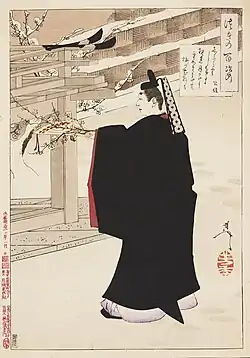 |
Kintō picks a plum branch in the moonlight | Poem: "In the midst of glimmering whiteness / among the night's moon-shadows / I part the snow and pluck plumb blossoms" - Fujiwara no Kinto, January 1887. Fujiwara no Kinto was considered one fo the pre-eminent poets and calligraphers of the Heian Period, and helped compile official poetry anthologies in his capacity as advisor to the Emperor. |
| 48 | 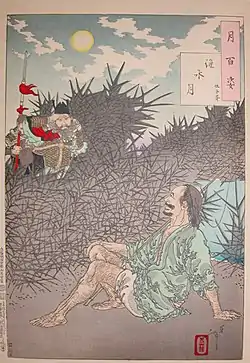 |
Huai River Moon - Wu Zixu (Waisui no tsuki - Goshisho) | |
| 49 | 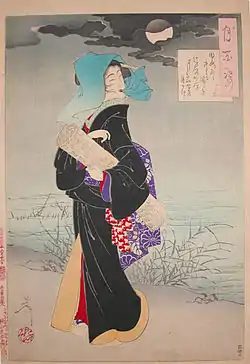 |
Streetwalker by moonlight | |
| 50 |  |
The moon and the helm of a boat (Daro no tsuki) | |
| 51 | 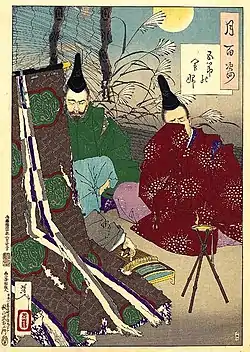 |
Lady Gosechi (Gosechi no myobu) | |
| 52 | 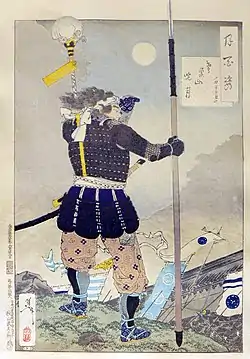 |
Mount Tobisu dawn moon (Tobisuyama gyogetsu) | |
| 53 |  |
Sumiyoshi full moon (Sumiyoshi no meigetsu) | |
| 54 |  |
Chinese beauty holding a stringed instrument | |
| 55 |  |
Fukami Jikyu challenges the moon | |
| 56 |  |
Gen'i viewing the moon from his castle | |
| 57 | 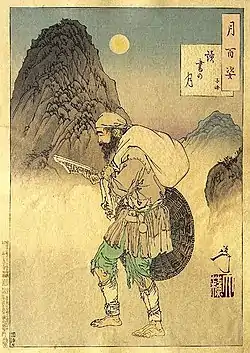 |
Reading by the moon (Dokusho no tsuki) | |
| 58 | 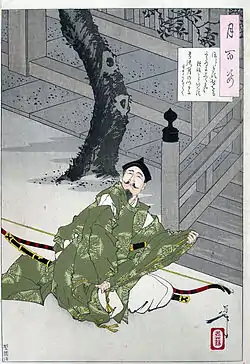 |
Does the cuckoo too announce its name from above the clouds? | |
| 59 | 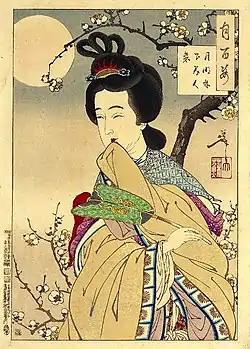 |
In the moonlight under the trees a beautiful woman comes (Getsumei rinka bijin majiru) | |
| 60 | 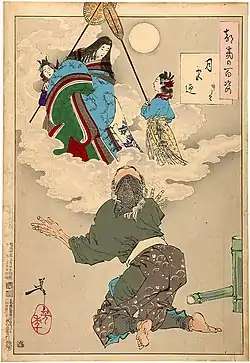 |
Received back into Moon Palace (Gekkyo no mukae) | This print depicts the last scene from the famous tale of the Bamboo Cutter's Daughter, as Kaguya-hime (かぐや姫) is escorted back to her home on the moon, reluctantly leaving her adoptive parent behind. |
| 61 | 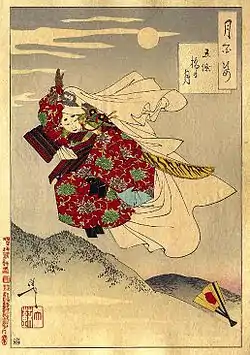 |
Gojo Bridge moon (Gojobashi no tsuki) | |
| 62 | 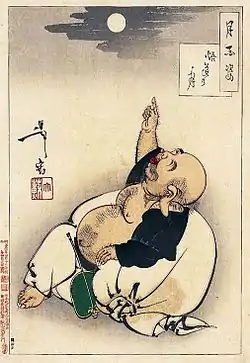 |
Moon of Enlightenment (Godo no tsuki) | |
| 63 | 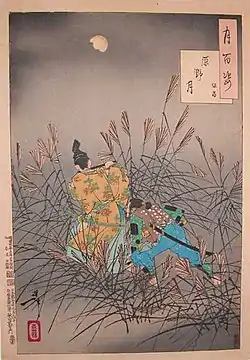 |
The moon of the moor (Harano no tsuki) | |
| 64 | 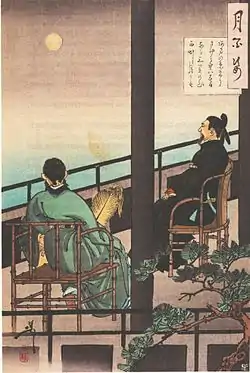 |
Nakamaro views the moon in China | Abe no Nakamaro was a member of an official delegation to China from Japan, and stayed for years before returning home. Viewing the moon here is a possible allusion to poem number 7 of the hyakunin isshu anthology. |
| 65 | 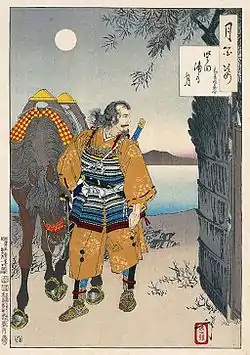 |
Katada Bay moon (Katadaura no tsuki) | |
| 66 | 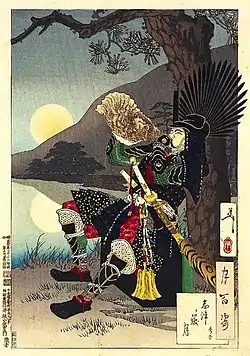 |
Shizu Peak moon (Shizugatake no tsuki) | |
| 67 | 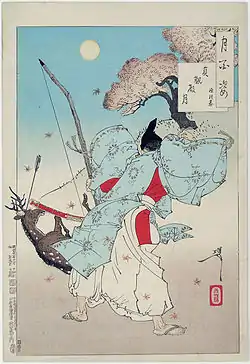 |
Joganden moon (Joganden no tsuki) | |
| 68 | 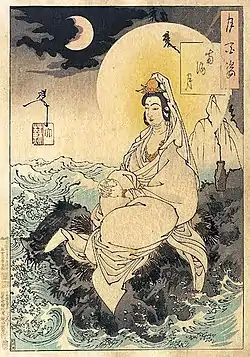 |
Moon of the Southern Sea (Nankai no tsuki) | |
| 69 |  |
Seson temple moon (Sesonji no tsuki) | |
| 70 | 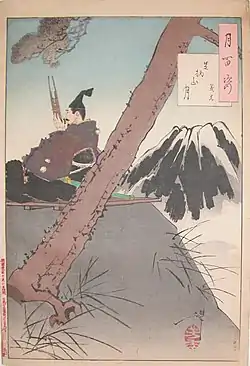 |
Mount Ashigara moon (Ashigarayama no tsuki) | |
| 71 |  |
Ishiyama moon (Ishiyama no tsuki) | |
| 72 |  |
Mount Miyaji moon (Miyajiyama no tsuki) | |
| 73 | 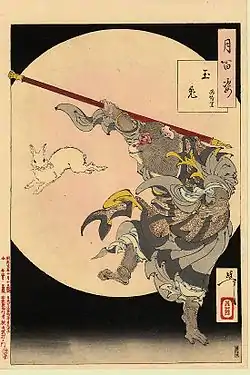 |
Jade Rabbit - Sun Wukong (Gyokuto - Songoku) | |
| 74 | 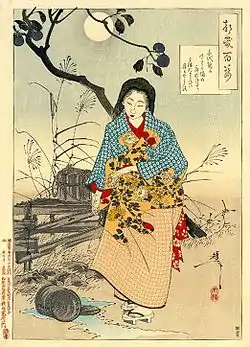 |
Lady Chiyo and the broken water bucket | |
| 75 |  |
Hidetsugu in exile | |
| 76 | 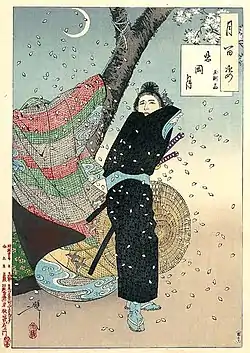 |
Shinobugaoka moon (Shinobugaoka no tsuki) | |
| 77 | 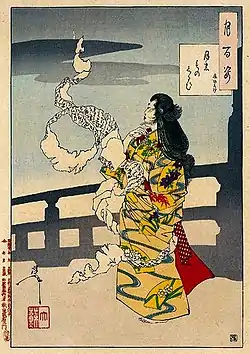 |
Lunacy - unrolling letters (Tsuki no monogurui - fumihiroge) | |
| 78 |  |
Rainy moon (Uchu no tsuki) | |
| 79 |  |
Dawn moon and tumbling snow (Seppu no gyogetsu) | |
| 80 |  |
Moon of the filial Son (Koshi no tsuki) | |
| 81 | 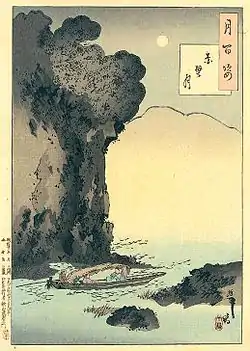 |
Moon of the Red Cliffs (Sekiheki no tsuki) | |
| 82 | 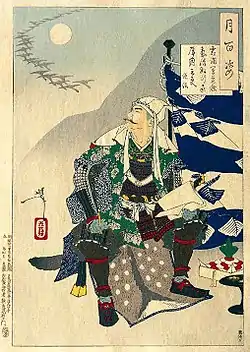 |
Uesugi Kenshin watching geese in the moonlight | Uesugi Kenshin was a major warlord during the Warring States period. |
| 83 | 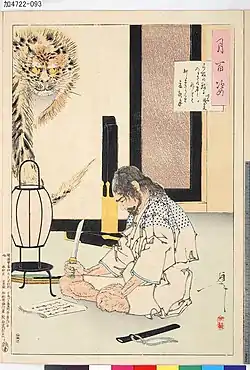 |
Akashi Gidayu writing his death poem before comitting Seppuku | Akashi Gidayu was a retainer to Akechi Mitsuhide, who followed him in death, but not before writing his death poem. |
| 84 | 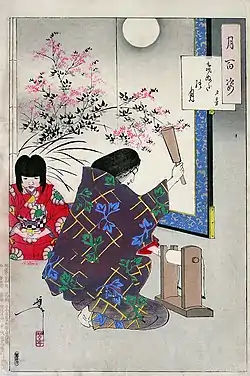 |
Cloth-beating moon (Kinuta no tsuki) | |
| 85 | 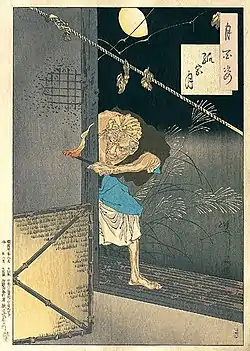 |
Moon of the Lonely House (Hitotsuya no tsuki) | |
| 86 | 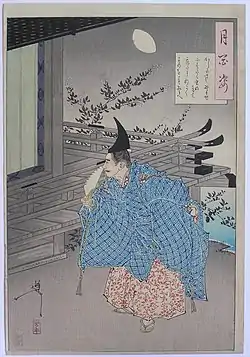 |
Rendezvous by moonlight | |
| 87 |  |
Moon of Kintoki's mountain (Kintokiyama no tsuki) | |
| 88 | 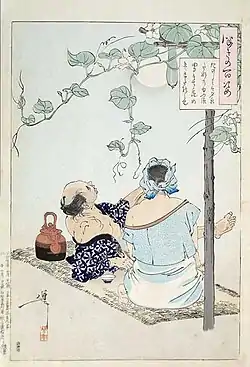 |
A country couple enjoys the moonlight with their infant son | |
| 89 | 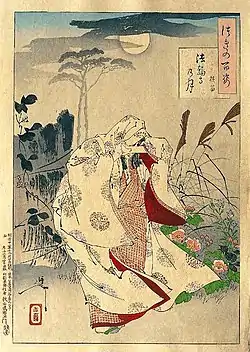 |
Horin temple moon (Horinji no tsuki) | "Yokobue was an attendant of the empress Kenreimonin in the 12th century. A young guard fell in love with her, but when his father objected to the match he left to become a monk at Hôrin temple in the mountains.
Yokobue travelled to see him, but fearing that he might be tempted to forget his vow, he made use of the fact that he had changed his name and sent a message that no one of the name she was calling was at the temple. Heartbroken, Yokobue departed. According to Heike monogatari (Tale of the Heike), she became a nun, but in the sixteenth century Yokobue sôshi (Book of Yokobue) she threw herself into the Ôi River and her lover ran down the mountain to find her drowned. The print shows her as she turns away to come down from the mountain, with the mood of the landscape reflecting her state of mind: the clouds covering the moon, the wind tugging at her robes, the fence a barrier between her and her lover, and the intertwined pine trees, symbols of conjugal happiness, disappearing in the mist. Her pose is suggestive of the meaning of her name, ‘transverse flute’. The depiction of the landscape recreates the effect of Rimpa screen painting, with the clouds and fence effectively carved to mimic broken brushstrokes." Publisher: Akiyama Buemon. First edition 20 December 1890[10] |
| 90 |  |
Kazan temple moon (Kazanji no tsuki) | |
| 91 | _-_from_the_series_'One_hundred_aspects_of_the_moon_(T..._-_Google_Art_Project.jpg.webp) |
Musashi Plain moon (Musashino no tsuki) | |
| 92 | 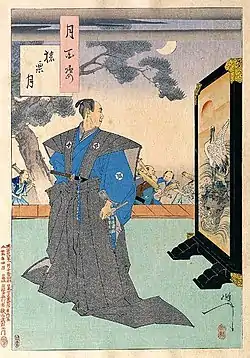 |
Monkey-music moon (Sarugaku no tsuki) | |
| 93 |  |
A Buddhist monk receives cassia seeds on a moonlit night (Bonso tsukiyo ni keishi o uku) | |
| 94 |  |
Moon on the Sumida River | |
| 95 |  |
The moon’s invention (Tsuki no hatsumei) | |
| 96 |  |
Chofu village moon (Chofu sato no tsuki) | |
| 97 | 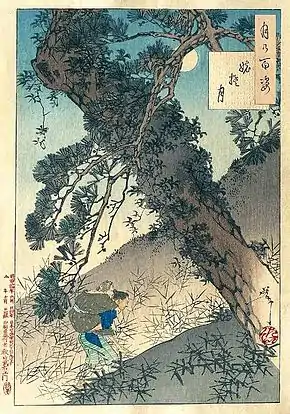 |
The moon and the abandoned old woman (Obasute no tsuki) | |
| 98 | 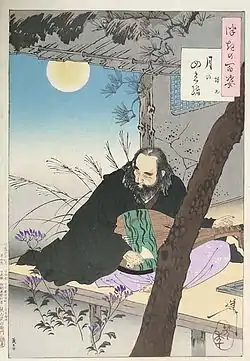 |
The moon’s four strings (Tsuki no yotsu no o) | |
| 99 |  |
Saga Moor moon (Sagano no tsuki) | |
| 100 | 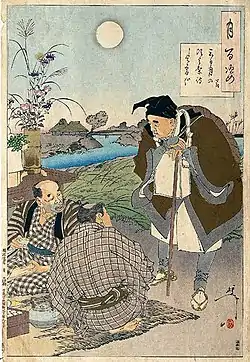 |
Farmers celebrating the autumn moon | |
References
![]() This article incorporates text by The Fitzwilliam Museum available under the CC BY 4.0 license.
This article incorporates text by The Fitzwilliam Museum available under the CC BY 4.0 license.
- "One Hundred Aspects of the Moon: Seson Temple Moon - Captain Yoshitaka, Library of Congress". Retrieved 2022-02-11.
- "One hundred aspects of the moon". Yoshitoshi: An online exhibition. Retrieved 25 November 2021.
- "Yoshitoshi's 100 Aspects of the Moon (Tsuki hyakushi)". yoshitoshi.net. Retrieved 16 February 2022.
- "A Poem by Takao". roningallery.com. Retrieved 16 February 2022.
- "Moon above the Sea at Daimotsu Bay: Benkei". Yoshitoshi: An online exhibition. Retrieved 22 November 2021.
- "Mount Yoshino Midnight-moon: Iga no Tsubone". Yoshitoshi: An online exhibition. Retrieved 2021-11-25.
- "Suzaku Gate Moon: Hakuga Sammi". Yoshitoshi: An online exhibition. Retrieved 2021-11-25.
- "Moon and Smoke". Yoshitoshi: An online exhibition.
- "The Yûgao Chapter from The Tale of Genji". Yoshitoshi: An online exhibition. Retrieved 2021-11-25.
- "Hôrin Temple Moon: Yokobue". Yoshitoshi: An online exhibition. Retrieved 2021-11-25.
External links
| Wikimedia Commons has media related to One Hundred Aspects of the Moon. |
